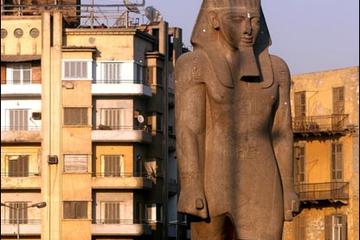
Ramses II was a the longest serving pharaoh in Ancient Egypt, reigning from 1279 BC to 1213 BC, a total of 66 years and 2 months. This made him a very powerful and significant man in history and it's not surprising he left behind so many huge statues of himself. One of these is the freestanding red granite statue reaching 36 ft (11 m) in height discovered by Giovanni Battista Caviglia in 1820 in Memphis, the ruined ancient capital city. It was broken into 6 pieces but in 1955 Egyptian President Nasser had it restored and installed in Cairo at Ramses Square. Pollution took its toll on the 3,200 year old sculpture however and in 2006 it was moved to Giza where it will be installed in the new Grand Egyptian Museum when that opens in 2013.
Other statues of Ramses II are found at Abu Simbel and Luxor. The British Museum also has one which was found at Thebes.
The plateau of Giza is the site of the pyramids and the future location of the Grand Egyptian Museum. Until then the statue of Ramses II is undergoing restoration. Giza is best reached by tour bus or taxi.